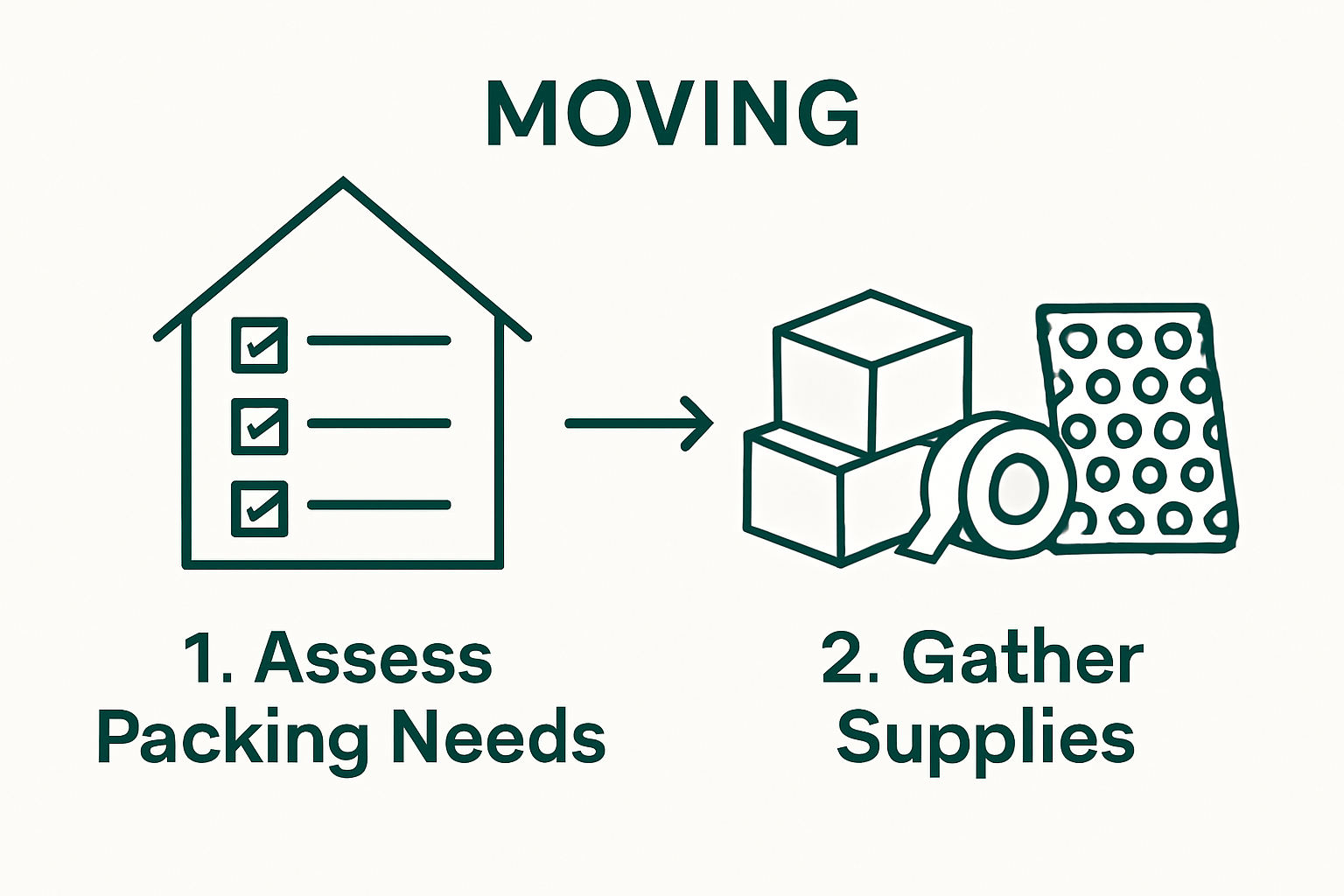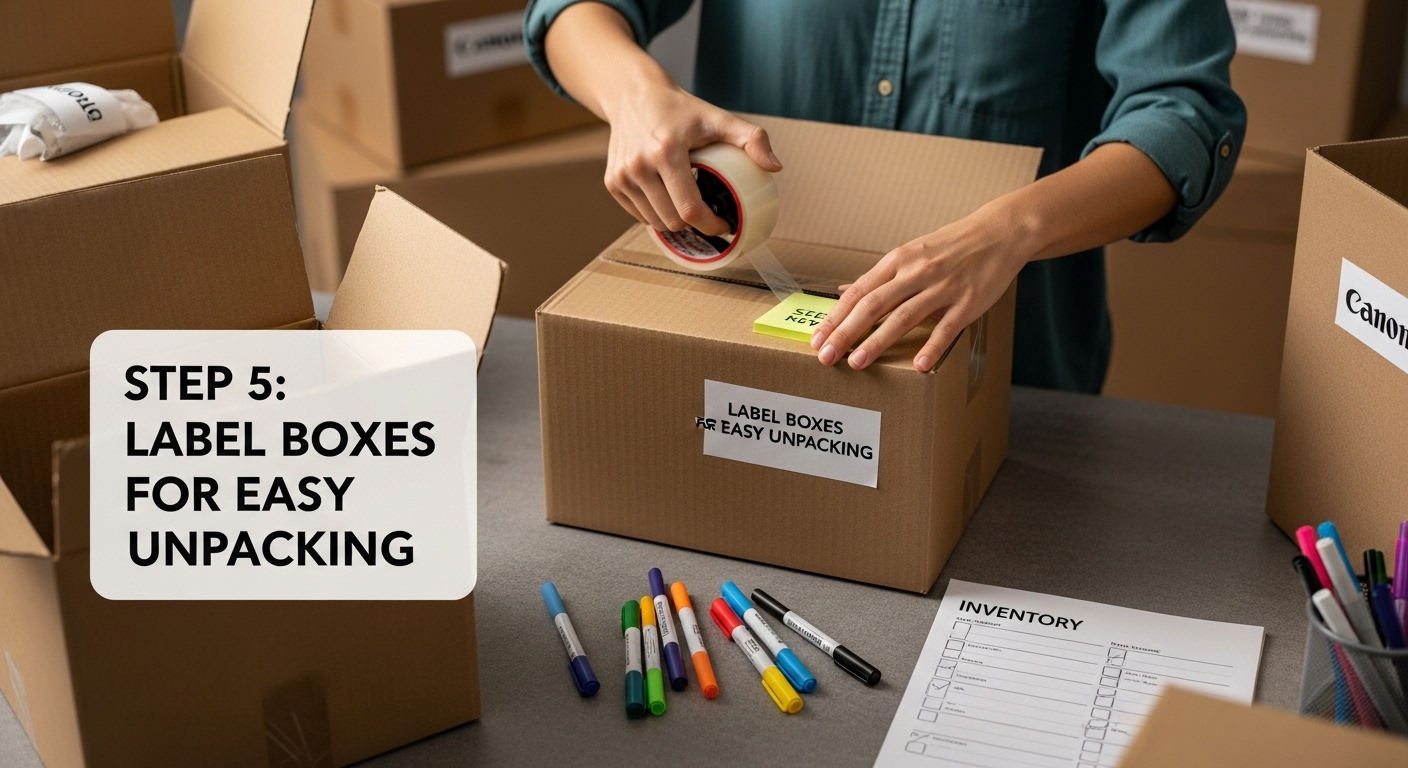Moving to a new place always sounds exciting until you face the mountain of boxes and endless checklists. Most people focus on getting everything into boxes as quickly as possible. Yet, studies show that a poorly organized packing process can increase the risk of item loss or damage by up to 50%. Smart packing is not just about speed or muscle. The real secret is a systematic process that can make your move almost effortless and save you countless headaches later.
Table of Contents
- Step 1: Assess Your Packing Needs
- Step 2: Gather Essential Packing Supplies
- Step 3: Organize Supplies By Room
- Step 4: Pack Items Efficiently
- Step 5: Label Boxes For Easy Unpacking
- Step 6: Verify Supply Inventory Before Moving
Quick Summary
| Key Point | Explanation |
|---|---|
| 1. Assess packing needs before moving | Conduct a thorough inventory of your items to understand what types of packing will be necessary. |
| 2. Gather high-quality packing supplies | Use sturdy boxes and quality tape to protect your belongings during the move. |
| 3. Organize supplies by room | Group packing materials per room to streamline the process and ensure nothing is overlooked. |
| 4. Label boxes with clear details | Use a consistent labeling system to identify contents and destination rooms, which aids in unpacking. |
| 5. Verify inventory before moving day | Double-check packed items against your inventory list to prevent losing any belongings during the move. |
Step 1: Assess Your Packing Needs
Successful moving starts with a comprehensive assessment of your packing requirements. Before purchasing a single box or rolling out packing tape, you need a strategic plan that accounts for the unique characteristics of your household items, their quantity, and potential complexity.
Begin by conducting a thorough home inventory. Walk through each room systematically, taking mental notes and preferably creating a digital or written record of items that will require packing. This isn’t just about counting boxes you’ll need. Your goal is understanding the diversity of items you own and their specific packing challenges.
Consider the different categories of items in your space. Fragile items like glassware, artwork, and electronics demand specialized packing materials and extra care. Large furniture pieces might require disassembly or specialized protective wrapping. Clothing, books, kitchen items, and personal collections each present unique packing considerations.
Potential variations in your moving scenario will significantly impact your packing approach. Are you moving locally or long distance? Will items be in storage temporarily? Are you handling the move yourself or hiring professionals? Each scenario introduces different packing strategy requirements.
Key items to assess during your inventory include:
- Breakable items requiring special padding
- Electronics needing original packaging or custom protection
- Furniture that might need partial disassembly
- Seasonal clothing and storage requirements
- Specialty items like musical instruments or artwork
According to the Federal Motor Carrier Safety Administration, obtaining accurate estimates and understanding your specific moving needs is crucial. By meticulously documenting your belongings and their unique packing requirements, you’ll set the foundation for a smooth, organized moving experience.

Once you’ve completed your comprehensive assessment, you’ll have a clear roadmap for purchasing the right moving packing supplies and preparing your items for transport. Remember, preparation is the key to reducing stress and potential damage during your move.
Step 2: Gather Essential Packing Supplies
With your detailed inventory complete, it’s time to collect the right packing materials that will protect your belongings during transit. Quality packing supplies are your first line of defense against potential damage, transforming a potentially stressful move into a smooth, organized experience.
Start by acquiring sturdy moving boxes in multiple sizes. While it might be tempting to collect free boxes from local stores, investing in new, uniform boxes provides consistent strength and stackability. Medium-sized boxes work best for most household items, while smaller boxes are ideal for heavy objects like books, and larger boxes suit lightweight items such as bedding and pillows.
Packing tape is not just an accessory but a critical component of secure transportation. Select high-quality, wide packing tape that provides robust sealing for your boxes. Avoid using household or masking tape, which can easily break or lose adhesion during moving. Professional-grade packaging tape ensures your boxes remain sealed and intact throughout the moving process.
Protective materials are equally crucial. Bubble wrap, packing paper, and foam sheets will safeguard your fragile items from potential impacts. Consider purchasing specialty protective materials for electronics, artwork, and delicate glassware. Old towels, blankets, and clothing can also serve as additional padding, reducing the need to purchase excessive protective supplies.
Essential packing supplies include:
- Strong, multi-sized moving boxes
- High-quality packing tape and tape dispenser
- Bubble wrap and packing paper
- Markers for labeling
- Protective padding materials
- Scissors and utility knife
According to Ready.gov’s emergency preparedness guidelines, having the right supplies prepared can make a significant difference in managing transitions smoothly. By carefully selecting your packing materials, you’re not just preparing for a move but creating a systematic approach to protecting your valuable possessions.
The following table summarizes key packing supplies, their purposes, and special notes to help you choose the right materials for your move.
| Packing Supply | Purpose | Special Notes |
|---|---|---|
| Moving boxes (various sizes) | Holds and protects items | Use smaller boxes for heavy items, large for light |
| High-quality packing tape | Seals boxes securely | Avoid household tape; use professional-grade tape |
| Bubble wrap | Shields fragile and breakable items | Ideal for glassware, artwork, and electronics |
| Packing paper | Provides surface protection and wrapping | Use to fill empty box spaces to prevent shifting |
| Markers | Labels boxes for room and contents | Prefer permanent, high-contrast colors |
| Protective padding | Adds cushioning for extra security | Old towels or blankets can also be used |
| Scissors/utility knife | Cuts tape and packing materials | Essential for fast and safe unpacking |
A pro tip: Purchase slightly more supplies than you initially estimate. Moving often requires more materials than expected, and having extra on hand prevents last-minute supply runs or improvised packing methods that could compromise your items’ safety.
Step 3: Organize Supplies by Room
Organizing your packing supplies by room transforms a potentially chaotic moving process into a systematic, manageable experience. Strategic room-by-room organization prevents last-minute scrambling and ensures each space receives focused attention. This methodical approach helps you track progress, minimize stress, and create a clear unpacking strategy for your new location.
Begin with the rooms least used in your daily life. Spare bedrooms, home offices, storage areas, and rarely accessed spaces are perfect starting points. This approach allows you to pack non-essential items early without disrupting your daily routine. Gather all supplies for each room before you start packing: boxes, tape, markers, bubble wrap, and protective materials specific to that room’s contents.
In each room, create a staging area where you’ll assemble boxes and organize items. Place your supplies within easy reach and create designated zones for packed and unpacked items. Systematically work through each room’s contents, sorting items into clear categories: items to pack, items to donate, and items to discard. This process not only streamlines packing but also helps you declutter and reduce unnecessary item transportation.
Label every box immediately after packing with its contents and destination room. Use a consistent labeling system that includes the room name, a brief description of contents, and whether the box contains fragile items. Colored stickers or markers can help quickly identify box categories and handling requirements.
Critical room organization strategies include:
- Pack one room completely before moving to the next
- Keep similar items together within each box
- Create an inventory list for each room’s packed items
- Reserve a “first night” box with essential items for each room
- Avoid overpacking boxes to prevent potential damage
According to University of Cincinnati Clermont College’s moving guidelines, proper labeling and systematic room-by-room organization can significantly reduce moving day stress. By approaching packing as a structured, room-specific process, you’ll create a clear roadmap for both packing and eventual unpacking.
Verify your room organization by walking through each space, ensuring nothing is overlooked and all boxes are properly labeled and sealed. A well-organized packing approach turns a potentially overwhelming task into a controlled, manageable moving experience.
Step 4: Pack Items Efficiently
Efficient packing is an art form that balances protection, organization, and strategic space utilization. The goal is not just to move your belongings, but to ensure they arrive safely and can be easily unpacked at your new location. Think of packing as creating a protective journey for each item, with careful consideration of its unique characteristics and potential vulnerabilities.
Begin with heavier items at the bottom of each box, creating a stable base that prevents lighter, more delicate items from being crushed. Distribute weight evenly to make boxes manageable and prevent potential structural failures during moving. Soft items like towels, blankets, and clothing can serve dual purposes as padding materials, providing extra protection for fragile objects while maximizing packing efficiency.
For breakable items, wrap each piece individually in bubble wrap or packing paper. Create a cushioning layer at the bottom of the box using crumpled paper or additional padding materials. Place wrapped fragile items carefully, ensuring they do not touch each other directly. Fill any empty spaces with additional padding to prevent movement during transit. Tight packing prevents items from shifting and potentially breaking during the move.
Electronics and valuable items require special attention. If possible, pack these in their original packaging. When original boxes are unavailable, use anti-static bubble wrap for electronic devices and create custom padding using soft materials. Take photographs of electronic setups before dismantling to help with reassembly at your new location.
Critical packing efficiency tips include:
- Pack similar items together
- Use clothing and linens as additional padding
- Fill boxes completely to prevent item movement
- Avoid mixing items from different rooms
- Create a “first night” box with essential items
According to Yale University’s moving guidelines, clear labeling and strategic packing can significantly reduce the stress of moving. By approaching packing as a methodical process, you transform a potentially chaotic experience into a controlled, organized transition.
Verify your packing efficiency by gently lifting and moving packed boxes. They should feel balanced, with no uncomfortable shifting of contents. A well-packed box is secure, well-labeled, and ready for its journey to your new home.
Step 5: Label Boxes for Easy Unpacking
Labeling transforms a complex moving process into a streamlined, organized transition. Effective labeling is more than just writing room names on boxes – it’s creating a comprehensive communication system that guides you and anyone helping with your move through the unpacking process.
Start by selecting high-quality, permanent markers in contrasting colors. Dark markers on light box surfaces ensure maximum readability. Create a consistent labeling system that includes multiple critical pieces of information. Each box should display the destination room, contents description, and any special handling instructions. This approach provides instant context for movers and helps you prioritize unpacking when you arrive at your new location.
Consider developing a color-coding system to enhance your labeling strategy. Assign specific colors to different rooms or categories of items. For instance, blue labels might represent kitchen items, green for bedroom supplies, and red for fragile objects. This visual method allows for quick identification and helps prevent mishandling of sensitive items during transportation.
Don’t just label the top of boxes – mark at least two sides to ensure visibility regardless of how boxes are stacked or positioned. Include your name, destination address, and a box number if you’re creating an inventory list. For boxes containing essential items you’ll need immediately upon arrival, use a bright, distinctive marker or sticker that stands out from your standard labeling system.
Critical labeling strategies include:
- Label boxes immediately after packing
- Use permanent, high-contrast markers
- Mark multiple sides of each box
- Create a master inventory list
- Note fragile items clearly
- Include brief content descriptions
According to University of Michigan’s LSA Movers, precise box labeling can dramatically reduce confusion and potential mishaps during moving. By treating labeling as a strategic communication tool, you’re setting yourself up for a smoother, more organized moving experience.
Verify your labeling by walking through your packed space and confirming that every box is clearly marked, easily readable, and includes all necessary information. A well-labeled collection of boxes tells a story of preparation and thoughtfulness, making your moving journey significantly less stressful.

Step 6: Verify Supply Inventory Before Moving
The final preparation stage before moving involves a comprehensive inventory verification that transforms potential chaos into a controlled, systematic transition. Inventory verification is your last line of defense against potential moving day complications, ensuring every item is accounted for and properly prepared for transportation.
Begin by creating a master inventory list that details every box you’ve packed, its contents, and its destination room. Walk through each room methodically, cross-referencing your packed boxes against this list. Pay special attention to valuable or fragile items, confirming they are not just packed but adequately protected. This systematic approach helps identify any overlooked items or potential packing gaps before the moving truck arrives.
Prepare a separate, detailed inventory of high-value or sentimental items. Take photographs of these items before packing, creating a visual record that can be useful for insurance purposes or personal documentation. Measure and note the condition of larger furniture pieces, ensuring you have a clear record of their state before moving. This documentation can be crucial if any damage occurs during transit.
Consider creating a “first night” box separate from your main inventory. This box should contain essential items you’ll need immediately upon arrival: important documents, basic toiletries, a change of clothes, phone chargers, and a few kitchen essentials. Keep this box with you during the move, rather than loading it with other packed items.
Critical inventory verification steps include:
- Confirm total number of packed boxes
- Verify labels on all boxes
- Check that fragile items are properly protected
- Create a photographic record of valuable items
- Prepare a separate “first night” box
- Double-check room-by-room packing completeness
According to the Federal Motor Carrier Safety Administration, thorough preparation and inventory verification can significantly reduce moving day stress and potential complications.
Verify your inventory by conducting a final walkthrough of your space. Ensure no boxes are left behind, all rooms are empty, and your master list matches the physical items packed. A meticulously verified inventory transforms moving from a potentially overwhelming experience into a controlled, organized transition.
Below is a checklist table outlining critical inventory verification steps to complete before your move to ensure nothing is missed and everything is properly secured.
| Step | What to Do | Why It Matters |
|---|---|---|
| Confirm total number of boxes | Count every packed box and check against list | Ensures nothing is left behind |
| Verify all labels | Make sure labels include room, contents, fragility | Streamlines unpacking and handling |
| Check protection for fragile items | Inspect boxes marked fragile for adequate padding | Reduces risk of breakage or damage |
| Create photo record of valuables | Photograph valuables and document their condition | Useful for insurance and peace of mind |
| Prepare ‘first night’ box | Set aside essentials you need right away | Avoids digging through boxes for immediate needs |
| Room-by-room packing check | Walk through each room and confirm completeness | Prevents accidental omissions |
Take the Stress Out of Packing and Moving with Stomo
You just learned how essential it is to plan, pack, and label with precision, but facing a mountain of boxes, fragile items, and an overwhelming checklist can feel like too much. Many people struggle with collecting supplies, managing time, and protecting valuables during a major move. That is exactly where STOMO Moving Solutions can make all the difference for your next transition.

Stop worrying about running low on supplies or packing under time pressure. We deliver high-quality mobile storage containers directly to your home, so you can pack at your own pace and follow every step from your Essential Moving Packing Supplies List. You can count on transparent flat rates, fast local support, and personalized moving help trusted by South Carolinians. Ready to experience a move as organized and easy as your packing strategy? Visit Stomo Mobile Storage and MOVEMO Moving Service or check out our Storage Solutions and see how we can make your move simple, secure, and stress-free. Reserve your unit now and start packing smarter today.
Frequently Asked Questions
What essential packing supplies do I need for moving?
You will need sturdy moving boxes in various sizes, high-quality packing tape, protective materials like bubble wrap and packing paper, markers for labeling, and scissors or a utility knife.
How can I ensure my fragile items are properly protected during a move?
Wrap each fragile item individually using bubble wrap or packing paper and create a cushioning layer at the bottom of the box. Avoid letting items touch each other directly and fill any empty spaces with additional padding to prevent movement.
What size moving boxes should I use for different types of items?
Medium-sized boxes are best for most household items. Use smaller boxes for heavy objects like books, and larger boxes for lightweight items such as bedding and pillows.
How important is labeling boxes during the moving process?
Labeling boxes is crucial as it helps you keep track of your belongings. Ensure each box has the destination room, a brief description of contents, and any special handling instructions for easier unpacking.
